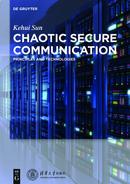Preface
Since meteorologist Lorenz discovered chaotic phenomenon in 1963, it has been widely and deeply studied. Chaos theory is known as the third scientific theoretical revolution following the theory of relativity and quantum theory in the 20th century. Especially, Pecora and Carroll reported chaos synchronization in 1990, which aroused an upsurge of study on chaotic secure communications. After more than 20 years of research and development, chaotic secure communication technology is becoming a new growth point in the field of information technology. On one hand, the application of chaos will continue to promote people’s profound understanding of the nature of chaos. On the other hand, the new problems in the application of chaos will further lead to the further research of chaos. Although chaotic secure communication technology still has a long way to go, the application of chaos in secure communication field shows us a promising prospect.
This book includes nine chapters. In the first chapter, the history of chaos research is reviewed, and the important characters and stories in the development of chaos are introduced, and the advances in research on chaotic synchronization control technology and chaotic secure communication method are reviewed. In the second chapter, the main analysis methods of the chaotic characteristic of the nonlinear system are presented. The typical chaotic dynamic system models are introduced briefly in the third chapter. In the fourth chapter, the principle and technology of the synchronization control between chaotic systems are investigated. In the fifth chapter, the technology and scheme of secure communication based on chaotic synchronization are discussed. In the sixth chapter, the data encryption technology based on chaotic sequences is discussed. In the seventh chapter, the audio and video real-time encryption communication technology based on chaos is studied. In the eighth chapter, the latest research progress, dynamic characteristic analysis, and simulation methods of fractional-order chaotic system are studied. In the ninth chapter, the design and implementation technology of chaotic circuit is studied.
In order to facilitate readers to grasp the important knowledge points in the book, the author lists a few questions at the end of each chapter. In order to facilitate the search of relevant literature and to publish the research results on time, journals about chaos research are listed as Appendix A of this book. In addition, in order to facilitate readers to quickly grasp the chaos of research methods, the author collected the relevant analysis programs as shown in Appendix B.
Based on the research results in the field and a large number of related literatures, this book is written through repeated modification.
In the field of research of chaos, the author has got the guidance and inspiration of many professors including Professor Sprott J C from the University of Wisconsin Madison in the United States, Professor Qiu S S from South China University of Technology, Professor Yu S M from Guangdong University of Technology, Professor Wang G Y from Hangzhou University of Electronic Science and Technology, Professor Zhang T S, Professor Sheng L Y, and Professor Zhu C X from Central South University. The author expresses sincere gratitude to all the professors. In addition, in the preparation of this book, previous graduate students gave a lot of support. They are Mou J, Zhou J L, Tan G Q, Ren J, Shang F, Wang X, Bao S Q, Yang J L, Cheng W, Liu X, He S B, Wang H H, Wang Y, Zuo T, Ai X X, Liu W H, Ruan J Y, Zhang L M, Xu Y X, Yu M Y, Yin Y H. Thanks for their contributions!
I would sincerely like to appreciate and acknowledge the comments and suggestions from the readers for this book.
Kehui Sun
January 2015, Changsha
